


|

|
| The Fuzzy Wuzzy Angels of Papua New Guinea |
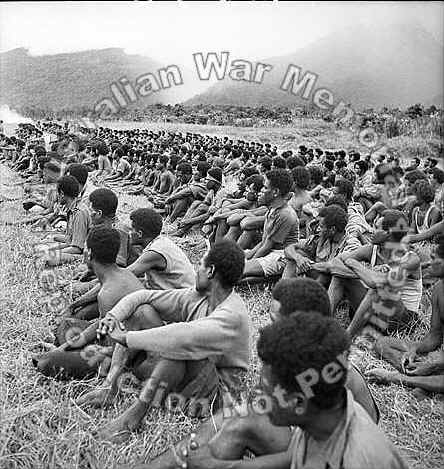 |
1942 was a terrible time when an invasion of Australia by the Japanese Imperial Forces looked almost inevitable. Diggers were fighting and dying on lonely jungle tracks in almost impenetrable jungle in mountain ranges so high that it was very cold at night time. It was then that we found a new set of friends. The men of the tribes of Papua and later of New Guinea flocked to help the Aussies. |
|||
Some fought independently because the Japanese mistreated them, something that the civilian Australian Patrol Officers had never done. Many were murdered by the Japanese. Naturally this built up a huge degree of loathing for the invaders. Some fought in organised Units and their story is told elsewhere on this website. However, they acted a bearers, mostly. They carried food and ammo forward and the wounded back. By so doing they created a legend. They were often praised as being as "gentle as a bush nurse". Australia owes them a Debt of Gratitude that is immense.
|
||||
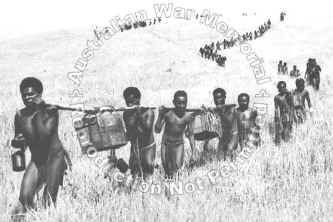 |
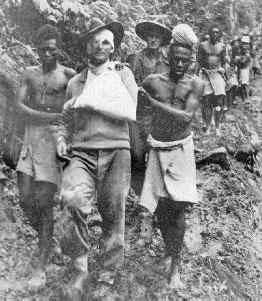 |
| Many Aussies would not have eaten or had ammo at the front without their help. These blokes are Chimbu. | Many wounded Diggers and Doughboys would not have made it back with out their help. |
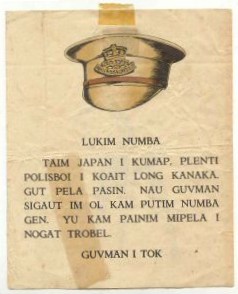 |
This is a
paper brochure or flyer distributed in PNG to attract Police Boys
(native police men) back to work after the Japs had been pushed back. It
is written in "pidgin", a simplified version of English that
started in China and has since spread around the world.
LUKIM NUMBA (look at the number) TAIM JAPAN I KUMAP (at the time Japan came) PLENTY POLISBOI I KOAIT LONG KANAKA (many police boys went into the bush (long kanaka)). GUT PELA PASIN. (Good fella, person to do this). NAU GUVMAN SIGAUT IM OL KAM PUTIM NUMBA GEN (Now the Government wants them all to come and put his number (badge) on again (go back to work)). YU KAM PAINIM MIPELA I NOGAT TROUBLE. (You can find me, I won't make trouble for you). GUVMAN 1 TOK (The Government is part of your family) |
| THE "FUZZY WUZZY" ANGELS |
|
THE
"FUZZY WUZZY" ANGELS by
NX6925
Sapper H "Bert" Beros of the 7th |
A
MOTHER' S REPLY
|
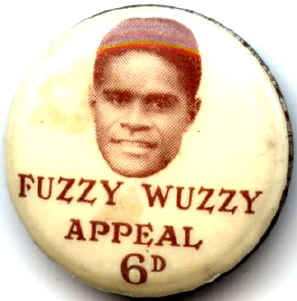 |
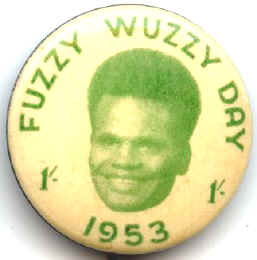
|
| The Fuzzy Wuzzy Angels of Papua New Guinea Page 2 |
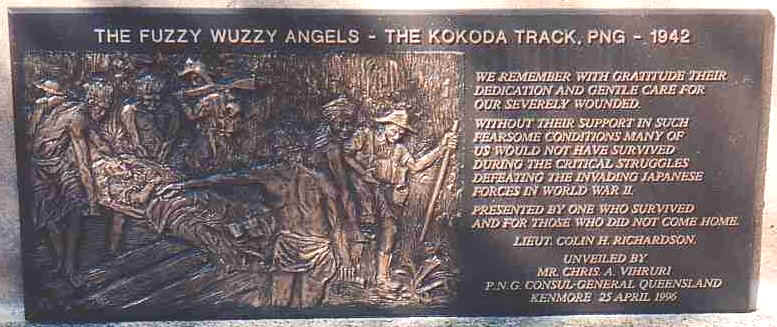
Photo from War Memorials in Queensland |
|
This plaque is in ANZAC Square in Brisbane as part of the tribute to the "Angels" Below is the Memorial erected in their honour. It depicts a Digger going up to the front passing a wounded Digger being helped by a Fuzzy Wuzzy Angel. |
|
|
| Photo from War Memorials in Queensland |
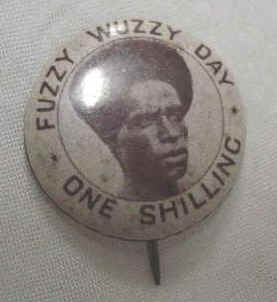 |
|
| The Fuzzy Wuzzy Angels of Papua New Guinea Page 3 |
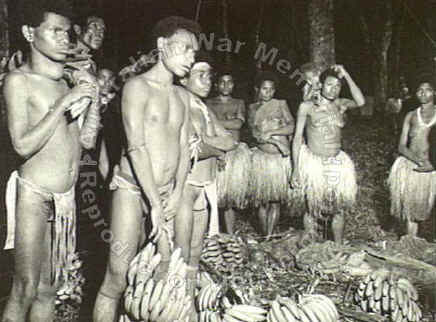 |
1942-11-19. NEW GUINEA. KOKODA. Natives bring in fruit for Allied troops. Payment is made on the barter system. Payment is also made in trade tobacco. Food, usually plentiful in this area, is now scarce, as the retreating Japanese burned down many of the native gardens. (Negative by G. Silk). |
|
The Book of Melanesian Pidgin English by Capt. John J Murphy (with additions) |
|
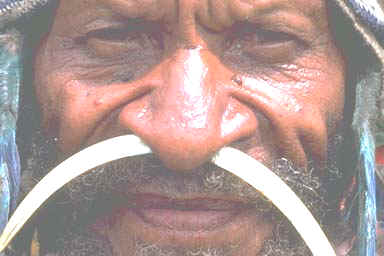 |
Subcategory Index
|
|
PNG has over 800 Languages! PNG is called "The Land of the Unexpected" with good reason. Most people you meet will speak three languages, and many people will speak 4, 5, 6, or 7! Pidgin is spoken in most areas. Tok Pisin, or Melanesian Pidgin, is one of the three national languages of Papua New Guinea. It is the most widely used language in the country, along with English and Motu. |
|
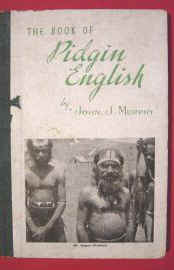 |
THE BOOK OF PIDGIN ENGLISH was written by Captain John J Murphy (Dept. District Services and Native Affairs) and Registered at the General Post Office Brisbane for transmission through the post as a book. Wholly set up, printed and published in Australia by W.R. Smith & Paterson Pty Ltd., Kemp Place, Valley Brisbane 1943. |
Webmasters note. The author
has done a great job of recording the language. What he has not fully
explained is the relationship between the Pidgin words and an almost
child-like Australian version of English.
I think it's fair to say that he didn't have to as in 1943 his audience was 99% Australian with a close understanding of the Australian dialect and jargon. Now that his work is being offered to an international |
| audience
it might be best if some explanation is made. For example: BUGARAP is
translated to "break, become impaired, have an accident" etc.
That is correct, but the root of the word is the Australianism
"Bugger up".
In the same way BARATA is given as "relative of same generation "etc which is correct but it's root is "brother". BIKKAMPANI is rooted in Big Company. PELA is rooted in "fella" (Australianism for man or male) so BIKPELA is "Big fella" as well as the given "large, big, important, great, huge. BIKPELA does not have to be human, so a "bikpela pukpuk" is a large (or big fella) crocodile. |
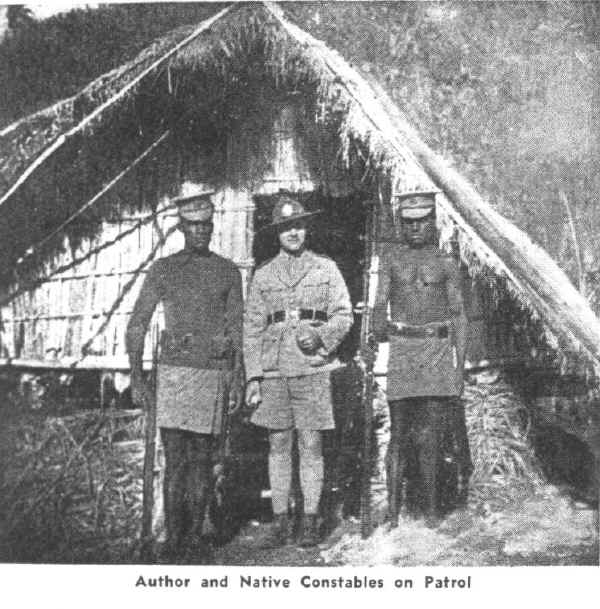 |
|
Foreword |
|
Captain John J. Murphy has asked me to write a foreword to "The Book of Pidgin English." BASIL MORRIS, Major General, G.O.C. ANGAU. Port Moresby, September 1943 |
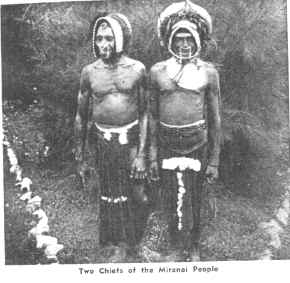 |
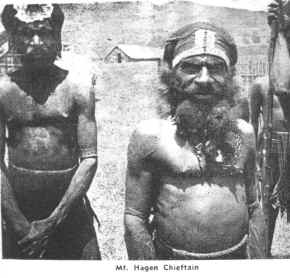 |
|
|
|
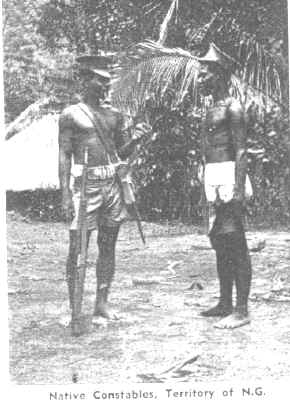 |
Preface |
| No attempt has been made, up to the present, to compose or standardize Melanesian Pidgin-English, and no book of reference Is available to those who desire, or whose work make it necessary, to have a good knowledge of Melanesian Pidgin-English.
Hence this book, which was undertaken as a step towards the classification of Melanesian Pidgin-English and its reduction to measurable and grammatical terms; also to stimulate, perhaps, worthier and more competent lexicographers to undertake the task of stabilizing the most widely (numerically and geographically) spoken language In the Territory of New Guinea. The system of orthography is discussed under the section devoted to spelling. It must not be supposed that all natives are good Pidgin English speakers. |
|
| On the contrary, many of them make
grammatical and phonetic errors and the size of the vocabulary varies with
individuals. It is possible that some natives are conversant with all the words defined in this book, but the average vocabulary of the sophisticated native is about nine hundred words. Localized native words, broken English and English words tricked out in Pidgin-English form have, of course, been omitted. A great deal of labour and research was spent in producing this book, and it is sincerely hoped that it will be a useful guide and book of reference to those who constantly use Pidgin-English as a medium of expression. John J. MURPHY, Department of District Services and Native Affairs. |
|
Apologia |
||
For example, kill is frequently translated as "kilim," and "shove" or "
push" as "pusim". |